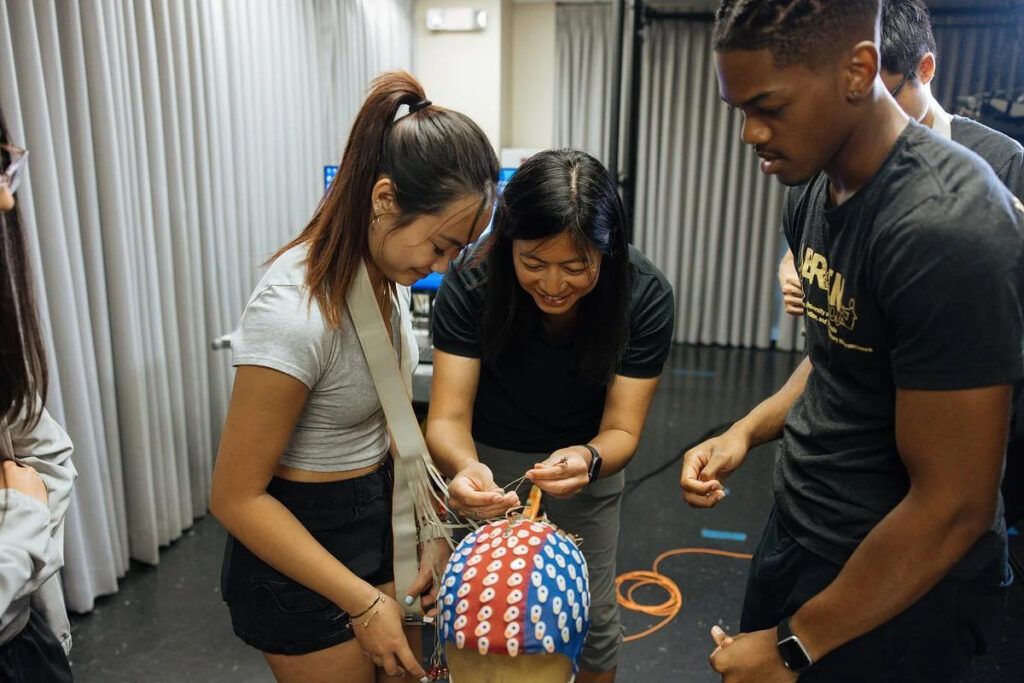In the BRaIN Lab at UCF, researchers are working to understand how the brain and body work together to control how humans move their bodies. Called the Biomechanics, Rehabilitation, and Interdisciplinary Neuroscience (BRaIN) Lab, students and faculty use electroencephalography (EEG) technology to measure the electrical activity of the brain during movement. But something even more is happening in the lab — the next generation of women in science and technology is being developed.
Helen Huang, the principal investigator of the lab and associate professor in mechanical and aerospace engineering, understands firsthand how STEM (science, technology, engineering, mathematics) is dominated by men. Nationally, just 25% of those working in computer occupations are women, and just 15% of engineers and architects are women, according to the Pew Research Center. But with women like Huang in STEM leadership roles, those numbers can change — something International Women in Engineering Day seeks to influence as it celebrates the work of women engineers annually on June 23.
“I think the most important thing [for women in STEM] is to have a supportive network,” Huang says. “Surround yourself with people who will encourage you to pursue what you’re interested in. There are plenty of women in STEM who would love to see more women in STEM.”

In the BRaIN Lab, Huang helps student researchers conduct human subject experiments and analyze large sets of data from the brain, muscles and body during challenging balance and walking tasks. By measuring electrical activity of the brain, computer algorithms can estimate where and when areas of the brain activate during movement — valuable insight that can design better robotic devices and rehabilitation for those with impaired movement.
For Lindsey Lee, seeing the BRaIN Lab was an “aha” moment. While studying a bachelor’s degree in mechanical engineering — which she just graduated from this spring — she discovered the lab and a way to combine her passion for sports, movement and math. Since, she’s worked in the lab to analyze people’s patterns of walking in response to perturbations on a treadmill and recently published findings in Gait & Posture that young and older adults increase their walking speed when a treadmill shifts rapidly from side-to-side, disrupting the normal walking pattern. Next, she will continue to analyze these findings and others in the BRaIN Lab while pursuing a master’s degree in biomedical engineering.
“Having Helen as a mentor has solidified my interest in the field and she’s encouraged me and helped build my confidence to continue onto graduate school,” Lee says. “I think it’s great to see a successful woman in this field. It can help inspire others who may not have similar examples in their life.”
For Shayla Hoa, a sophomore in mechanical engineering, the BRaIN Lab and Huang’s success also have influenced her career interests.
“I often find myself surrounded by male classmates, but witnessing Helen’s remarkable career achievements and the strides she’s made has given me a sense of assurance to persevere,” Hoa says. “The BRaIN Lab has given me hands-on experience conducting human-subject experiments and collaborating with more experienced peers who I can depend on for guidance.”
Huang hopes interest in the BRaIN Lab and biomedical engineering continues to grow. She feels it will at UCF, as master’s and doctorate degrees in biomedical engineering are now offered. Limbitless Solutions, a nationally recognized nonprofit at UCF that designs and builds personalized prosthetics more affordably thanks to its 3D-printing technology, also has brought more attention to the growing field. UCF also offers a minor in bioengineering, which prepares students for careers in medical research and development.
As understanding of brain activity and human movement grows, ultimately Huang hopes to help preserve mobility.
“The end game is to make sure everyone can maintain their mobility,” she says. “Mobility is a big part of our quality of life. It can greatly impact what we do, our mood, our ability to be independent. Our ultimate goal is to help our growing population in this way.”
